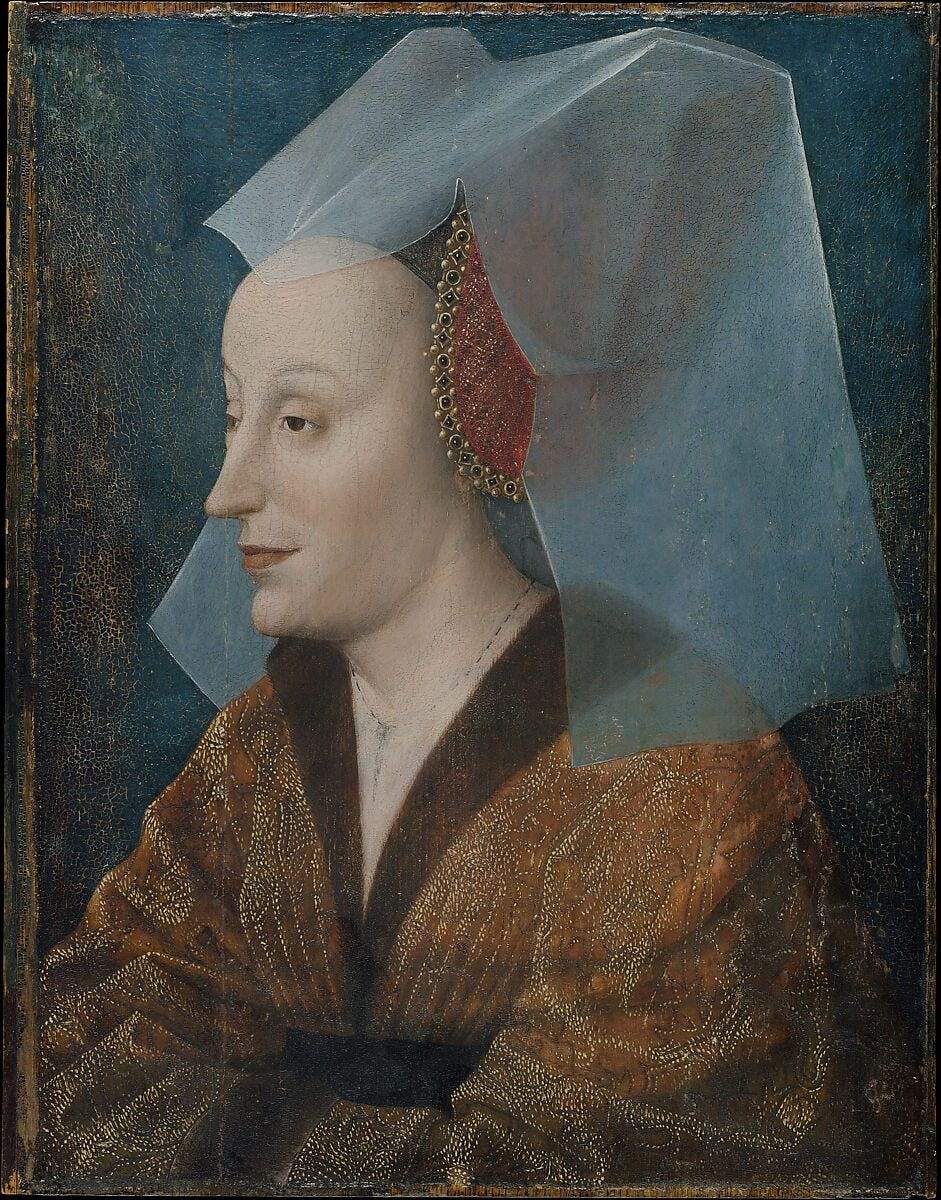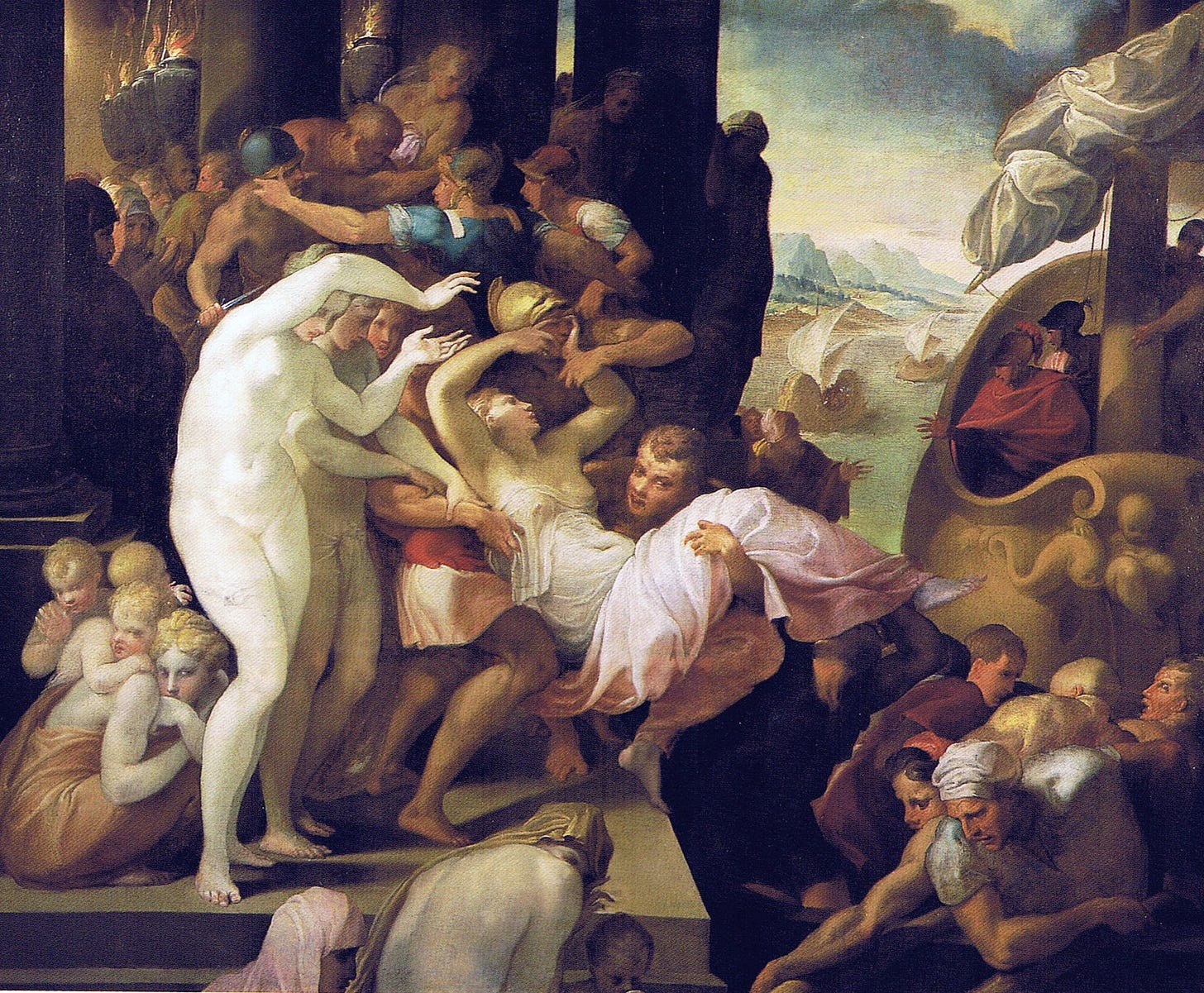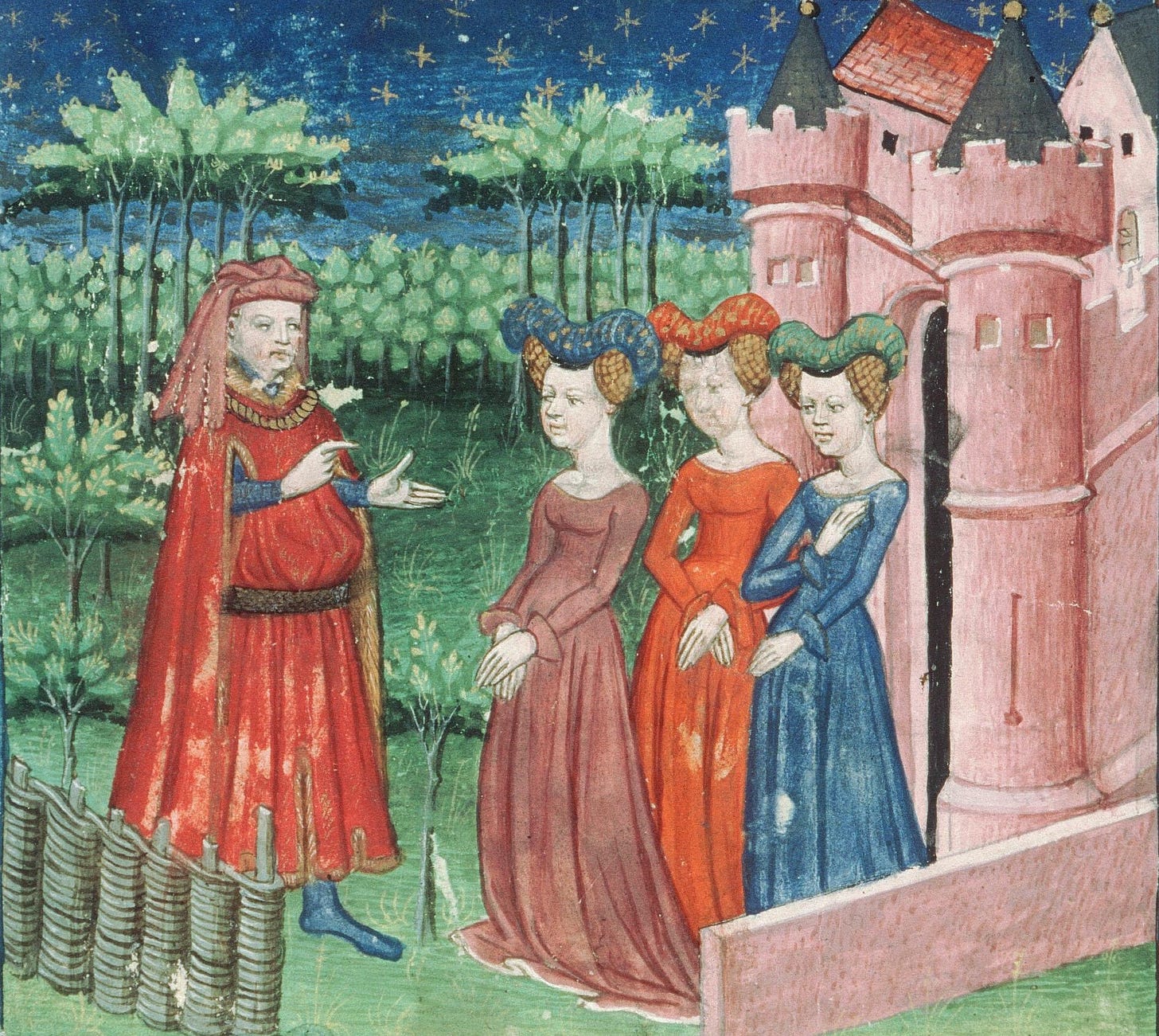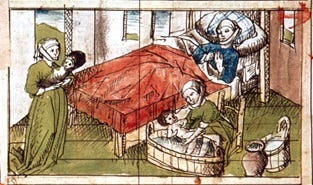Selling Womanhood: The Medieval Conceptualization, Capitalization, and Concealment of Women's Bodies
In TWO Parts - Part ONE
So much of the scholarship utilized within this space is only made possible through the labor and expertise of women. I’ve written about this before, but when women gain access to education, they often utilize that education and the access academia provides to uncover women that were previously lost to us due to the androcentric nature of our patriarchal reality. Women writing women. Women inspired by women. Women uplifting women.
As always, my goal is to share these women with you in hopes of shifting the collective conscious away from the false-belief in patriarchal naturality towards an awareness and deconstruction of the dominant social and political constructs of our lifetime—all in hopes that we can move towards a more sustainable egalitarian future. A small task, really.
Through the above, I also aim to share the extensive scholarship dedicated to reestablishing women into the historical narratives and the (mostly) women performing that labor, utilizing their own voices in the process.
And much like the women who put forward in words the inspirations of women past, the below piece was influenced by some of the incredibly thought-stirring, patriarchy-confronting women of this platform. had me pondering the classist nature of body standards both within the Middle Ages and now. had me unpacking patriarchal-conformity signaling coupled with the influence of himpathy within the exploitation of women’s bodies. ’s words ignited thoughts on the forceful erasure of women. ’ unpacking of male flight from higher education and the reaction it triggered from those declaring biology felt eerily similar to the aggressive co-opting of women’s spaces at the conception of capitalism. The voice of was in my mind as I thought over the concept of private property and the loss of the commons. and stirred thoughts on the selling of femininity and the invisible labor of women, respectively. While encouraged me to unpack my view on TradWives and reminded me of the policies that create such gendered labor in the first place. I am better for having access to your paradigms transmitted through words, and I am grateful. Thank you.
After working on this piece, I am here to unabashedly tell you I’ve turned on paid subscriptions for The 15th Century Feminist. With that being said, I believe a more egalitarian future will need to be predicated upon equitable access to education, so my posts will always remain free-to-read—if you have the means to financially support and wish to recognize my labor, you can do so below and I would be very grateful. If like me you don’t have extra to spare, a like, a restack, and/or a comment are just as supportive and just as appreciated. Thank you for being here.
Part One
Chaste. Silent. Obedient. Mindful. Cutesy. Demure. Youthful. Lively. Flexible.
So many gendered adjectives, so little time. Each propped up as a pillar of femininity, sold to women over the centuries as the preferred expressions for gender conformity within that contemporary moment. A conformity necessary for the acquisition of social and financial capital within patriarchy both during the Middle Ages and modern era alike. A research paper long sought after for its insights into the medieval diet amongst various English serfdoms recently rendered me routed. Not in the way that sometimes happens when researching and a line-of-thought proves folly by multiple sources, but in the way of a particular work suddenly feeling inaccessible, disconnected. For in the opening sentence the historian boldly declared (in so many words) that class is far more punishing than gender.
Deep sigh.
The complete negation of women being found within every level of the medieval English social class system seems like quite the oversight from the definitive paper. As Black feminists have long been emphasizing, an investigation into the impact of class without also unpacking the impact of gender disparity within said social construct only serves to further ostracize the already marginalized. As Cindy Courville states within Patriarchy as a Mode of Production, “the primary motivation of the patriarchal class is the accumulation of social dependents”—emphasis mine.1
Any system created under patriarchy is predicated upon the oppression and othering of women. And because there is a constant (read: intentional) conflation of the term patriarchy to mean men, I wish to clarify that I don’t mean all men oppress and other women, however, it is certainly true that all men benefit from the oppression and othering of women. Both can be true at the same time, regardless of any discomfort that arises. Our understanding of race was conceptualized to justify brutality as our conceptualization of gender is used to justify patriarchy.
This is the abridged version, in two parts, of how patriarchy sold us womanhood.
Conceptually Selling ‘Womanhood’
Beauty and body standards are indicative of the culture they stem from, but more than that, they offer some evidentiary support to gender and class norms of any specific time. Amongst the lower classes of medieval England a thicker, more robust woman was the ideal—a woman carrying extra weight had access to food, and access to food generally meant access to some form of wealth. Within the nobility, the opposite was true. A thinner, emaciated frame was thought to be more desirable. This thinness a testimonial of spiritual devotion and an ability to fast without fear of starvation—patriarchy privilege signaling, if you will.2
Socialized gender expectations require(d) women to constantly strive for and perform the established ideals. Any deviation from these patriarchy-imposed standards was (is) met with deft redirection through thinly-veiled threats of total devastation—as we’ll see play out later. To investigate class without considering the intersection of gender ignores the multi-layered oppressions women face(d) within imperialist patriarchy.3
A woman incorrectly performing body standards within the medieval English nobility may have been out of favor in terms of receiving the reward of the male-gaze4, but she wouldn’t have been in an untenable situation. The same can not be said of her working class counterpart. Had our worker participated in the fasting required of the pious nobility, regardless of body type, her caloric deficit due to the realities of hard daily labor and limitations of foodstuffs would have potentially left her fatally under-fueled.5 Addressing overlapping inequities is essential if we are authentically seeking a more robust understanding of the lived-realities of humans past.
If we hold fast to the censorious belief that class is in fact more punishing than gender, then we run the risk of minimizing the overlapping oppressive realities both class and gender impose(d) upon women.6
The women of medieval England, regardless of class, were socially expected to provide the devastatingly dangerous physical labor of repopulating (and breastfeeding!) post-plague years—and, well, every other year too. Wealthy women could afford costly calcium-dense animal cheeses, which supported both their own bone density and the (usually) several nutrient-demanding pregnancies they endured. Even if they were unaware of the benefits, they still had access to receive them. Women of the lower social classes did not. Often leaving them undernourished for the laborious—and too often fatal—task of child-birth and lactation production.7
Beyond how women were (are) meant to be shaped, so too did the patriarchy dictate how women were (are) meant to look. And absolutely no one was more of the quintessential babe than Helen of Troy.8
I’ll give you a moment to process the brutal reality that a woman who was in fact not real was seen as the ultimate ideal.9
“A horse, a horse, my kingdom for a horse!”
Though Helen was the standard, you’d have been hard pressed to get a true description of her within the Classics. Great legs? Check. Cute lips? Check. White? Check. Blond? Check. Downcast eyes to imply obedience? Definitely check.10 Didn’t qualify? Too bad. Instant exclusion for everyone else. Because of these strict parameters, “beauty” was inaccessible to most women.
But—there is always a but—this didn’t just exclude women from the gift of male-attention, it also blocked them from accessing even the sightliest bit of power their lived reality may have allowed them. Beauty was seen as a virtue, rendering it impossible to be virtuous if you weren’t also beautiful. As Eleanor Janega points out within The Once and Future Sex, we don’t often get detailed descriptions of classical beauties because the proof was in their power: “Their looks functioned to underline why they were in positions of power”—again, emphasis mine. To be powerful was to be beautiful. To be beautiful was to be virtuous.11
This is the power of the white supremacist patriarchal single story12: it has the ability to frame beauty as virtuous while simultaneously positioning the seeking of said beauty—and by extension, power—as salacious and therefore socially unacceptable. The subtlety of the positioning of power as masculine and beauty as white is meant to read as an outcome of society’s “natural” progression rather than the intentionally propagated paradigm that it is.
Fourteenth century France was tumultuous at the best of times. One specific fracas emanating from the continent, which inevitably impacted the easily-influenced-by-perceived-power patriarchs of medieval England, was Geoffroy de la Tour Landry.
Between 1371 and 1372, concerned dad Geoffroy wrote a behavioral guidebook for his daughters.13 Within it he urged his daughters to employ manners, be obedient, and radiate chastity, as these were all benchmarks of femininity. The respectability ascribed to him through his patriarchal position of power both as lord of the land and lord of the house was all that was necessary to render him an expert in the correct manifestations of womanhood.14
And therfor, doughtres, all gentillwomen
and nobill maidenes comen of good kin ought to be goodly,
meke, wele tached, firme in estate, behaving, and maners, litell
softe and esy in speche, And in answere curteis & gentill, and not
light in lokinge.Under the constructs of imperialist patriarchy, men not only dictate(d) the definitive woman, but profit(ed) off of doing so. The appropriation of Antiquarian thought into the established and enforced social constructs of the Middle Ages ensured men had access to education.15 Men had access to apprenticeships under well-connected patrons and the protection of guilds.16 Men had access to both inherited and loaned capital, access to fraternal spaces to proliferate paradigms, and—perhaps most importantly—access to social capital allowing all else to be made possible. Exhibited finely in the form of famed printer and faithful patriarch, William Caxton, who would go on to translate and print la Tour Landry’s guidebook into English in 1483.
While men such as papa Geoff purported and perpetuated patriarchal gender expectations, advising against such practices as the perilous act of applying makeup, writing “I heard tell from many that when she was dead, her face became such that one could not know what it was, nor what type of deformation; because it did not seem at all to be the face of a woman, nor did anyone take it for the face of a woman, so hideous was it and horrible to see. So, I think indeed that the layers of paint that she put on it were the cause of this phenomenon.”17 The patronizing pronoun switch subtly likening gender performance to identity, reminiscent of modern day trans-exclusionary feminists. History, on the other-hand, would report that beauty would be rewarded with extreme and nigh-impossible-to-achieve-elsewhere status elevation. Looking at you, Clovis II.18
Subsumed into the progression of patriarchal constructs was (is) the divine right of both beauty and masculinity, ordaining both should profit by way of power, as we still see play out today. But the hierarchical nature of patriarchy meant that medieval English women could only legitimately access the aforementioned power afforded to them through proper gender performance and acquiescing all social independence.
The Capitalization of Labor ‘Womanhood’ Demands
While the modern TradWife capitalizes upon the labor patriarchal womanhood demands, so too do those benefiting from said labor. In short aesthetic video clips, virtuosity is captioned and gendered while the burden of domestic labor is positioned as the blessings of femininity. Papa Geoff would be so proud. Under the caption, comments flood-in framing feminism as the masked thief in the night, robbing women of such natural pursuits, pressing them into the workforce against their will.19
The TradWife’s beauty is rewarded in social currency and capital gains the same way the medieval woman’s was, as long as she continues to pedal prescriptive propaganda—or, said less alliteratively, continues externally validating a certain form of femininity. A femininity which promotes women as non-workers, social dependents.
Be that as it may, even one of England’s most revered medieval patriarchs understood that women worked, and always have.
Found within labor ordinances issued by Edward III in 1349 is a decree which required all citizens of the realm under the age of sixty to get a job, so to speak. The ordinances—which read eerily similar to the modern corporate grievance of ‘no one wants to work anymore’—absolutely included women, confirmed by court records and reconfirmed by additionally issued ordinances which further safeguarded patriarchal privileges initially left exposed.20 From the onset its clear that Edward was aware domestic labor would suffer if women had to work externally to the home in a waged manner, as strict language prohibited the poaching of domestic laborers, regardless of what possessed capital may have allowed.
Though it may be implicated within such language, this isn’t to say women weren’t working prior to the ordinances, in fact, studies indicate women were found within every sector of the medieval economy.21 Socialized gender norms burdened women with domestic labor while respectability politics of the upper classes encouraged the same blessed gendered labor be delegated out at a lower cost.
This time period is often considered the golden era of the waged worker, as the bubonic plague removed a crippling amount of workers from the economy in a similar fashion that COVID did ours—except amplified to an unfathomable degree. It altered the social, political, and economic landscape indefinitely. Though the men of the time may have experienced increased wages due to scarcity, that certainly wasn’t so for the women.22
Outside of the initial wage boom under the market laws of supply and demand and especially once later ordinances were issued, wage work required time and as women were expected to manage the domestic labor on top of their waged labor, they had less of it to spare.23 The patriarchs further amassed wealth as the women further acquired labor categorized as non-work, which absolutely included motherhood. Men and women alike were expected to be functional participants in the community’s economy, while only women were required to function within the domestic one.24
Within London, married working women were able to apply directly to the mayor in order to receive the status of femme sole, a woman alone. This allowed our medieval woman to practice her trade unattached from her husband, since by law she was declared socially dependent upon marriage. If she had brought an inherited trade into the marriage, for example, this designation allowed it to remain her own, avoiding a dissolution into her husband’s assets. Though this status allowed women access to gain capital, earned family finances were considered the domain of men. Ultimately, this system was implemented to protect men alongside ensuring economic continuity.25
As imperial legalities dictated the transition from home-production into a more regulated commercialized one, what was socially considered women’s work became even more aligned with domestic labor. Where once a woman could produce capital goods or services alongside her domestic duties, now she would be required to provide that craft in a rented space, and since women couldn’t access capital without inheritance (single women and widows) or permission (married women), this left few options outside domestic servitude. By the turn of the 16th century, women’s work had been obfuscated to support men’s respectable professions.
Like the husbands of the femme soles, the men married to these TradWife influencers reap the financial rewards. Capitalizing on the perpetuation that domestic labor is somehow incorporated into femininity, rather than productivity, and saluted for respectfully allowing their wives to become social dependents.
Courville, Cindy. “Re-Examining Patriarchy as a Mode of Production : The Case of Zimbabwe.” Theorizing Black Feminisms: The Visionary Pragmatism of Black Women., 1993.
Jane Whittle & Mark Hailwood. "The gender division of labour in early modern England," Economic History Review, Economic History Society, vol. 73(1), pages 3-32, 2020
This is also true in regards to the intersection of class, gender, and race. Rural England of the 1300s was a fairly homogeneous affair while trade cities boasted far more diversity. If women held the lowest rung of social currency, non-white women would have been regarded as below that. Country of origin also mattered during time of war, as we see with the treatment of Margaret of Anjou—even with the protections of privilege. Our modern day white supremacy stems from medieval xenophobia.
And in patriarchy, this is considered a reward
Pearson, Kathy L. “Nutrition and the Early-Medieval Diet.” Speculum, vol. 72, no. 1, 1997, pp. 1–32. JSTOR, https://doi.org/10.2307/2865862.
Please, please read Black Feminist Literature. I beg thee.
Pearson, Kathy L. “Nutrition and the Early-Medieval Diet.” Speculum, vol. 72, no. 1, 1997, pp. 1–32. JSTOR, https://doi.org/10.2307/2865862.
Janega, Eleanor. The Once and Future Sex: Going Medieval On Women's Roles in Society. First edition. New York, NY, W.W. Norton & Company, 2023.
I feel it important to note here that the iconography surrounding women of the lower social classes would have been different than the tapestry, manuscript-filled reality of the nobility. Pillowy (I specifically use pillowy here to both imply lower belly fat and white skin) Mother Mary was the woman the lower class would have been socialized to see as a more realistic ideal.
The below line is Shakespearean for “I hate it here.”
Shakespeare, William. The Tragedy of King Richard III. Oxford Paperbacks, 2001.
De excidio Troia Historia. Ibid. Homer. Sappho. Boethius, respectively
Janega, Eleanor. The Once and Future Sex: Going Medieval On Women's Roles in Society. First edition. New York, NY, W.W. Norton & Company, 2023.
A concept introduced by African Feminist Chimamanda Ngochi Adichie
The Book of the Knight of La Tour-Landry, EETS o.s. 33, London, ed. Thomas Wright (from MS Harley 1764 and Caxton's Print) rev ed. 1903
Ibid. for the below quote
Not all men.
Very few medieval English trade guilds allowed women, and if they did allow women, they did not allow them to participate in leadership rolls, as “dictated” by governmental ordinances.
Goldberg, P.J.P. Women, Work, and Life Cycle in a Medieval Economy: Women in York and Yorkshire c.1300-1520 (Oxford, 1992; online edn, Oxford Academic, 3 Oct. 2011)
Chapter XIII, The Book of the Knight of La Tour-Landry, London, ed. Thomas Wright (from MS Harley 1764 and Caxton's Print) rev ed. 1903
Janega, Eleanor. The Once and Future Sex: Going Medieval On Women's Roles in Society. First edition. New York, NY, W.W. Norton & Company, 2023.
Blaming feminism for capitalism is interesting.
Humphries, Jane, and Jacob Weisdorf. “The Wages of Women in England, 1260–1850.” The Journal of Economic History, vol. 75, no. 2, 2015, pp. 405–47.
Hanawalt, Barbara A., 2007. "The Wealth of Wives: Women, Law, and Economy in Late Medieval London," OUP Catalogue, Oxford University Press, number 9780195311761.
Ibid.
Goldberg, P.J.P. Women, Work, and Life Cycle in a Medieval Economy: Women in York and Yorkshire c.1300-1520 (Oxford, 1992; online edn, Oxford Academic, 3 Oct. 2011).
If this feels disturbingly similar to today’s invisible mental load, that is the point.
Federici, Silvia. Caliban and the Witch. Autonomedia, 2004.
Goldberg, P.J.P. Women, Work, and Life Cycle in a Medieval Economy: Women in York and Yorkshire c.1300-1520 (Oxford, 1992; online edn, Oxford Academic, 3 Oct. 2011)
Hanawalt, Barbara A., 2007. "The Wealth of Wives: Women, Law, and Economy in Late Medieval London," OUP Catalogue, Oxford University Press, number 9780195311761.
Humphries, Jane, and Jacob Weisdorf. “The Wages of Women in England, 1260–1850.” The Journal of Economic History, vol. 75, no. 2, 2015, pp. 405–47.


















Thank you so much for the mention, I'm honored to be included among so many great female writers here! ❤️ Wonderful read! I always find it dissapointing when seemingly left-leaning people—though it's usually men—focus on class and class alone in their critique of our modern world, as if it exists, or has ever existed, in complete isolation from gender and other identities.
Early morning read. Intrigued and will watch for Part 2!
Initial comment: sigh…. It is a lot and goes back so very far, this stuff.